Intestinal Fortitude: Happy Bellies Teaches to Eat for Digestive Health
By Alice Levitt [01.16.13] Published in 7 Days Burlington Newspaper.
Originally published January 20, 2013.
Though personal therapeutic chef Tara Carpenter uses the word “diet” to describe her cooking methods, her Vermont business, Happy Bellies, is not focused on privation. “We use a lot of fats. Goose fat, duck fat, pork fat. If I see a farmer downtown, I say, ‘Did you just slaughter?’” she says with palpable excitement.
Weight loss can be a pleasant side effect, but it’s not the purpose of Carpenter’s cuisine. Her aim is healing.

Fresh ghee, pork lard, and beef tallow grace the kitchen counter.
Currently a 2nd-year online student in holistic nutrition consulting at Bauman College in Penngrove, Calif., Carpenter, 38, believes 70-80% of the immune system is part of the digestive system. While a few of Carpenter’s recommendations may sound radical — one involves consuming the postnatal placenta — the principles undergirding them may not be, according to Carol Gardner, a Colchester osteopath and nutritionist who has not worked with Carpenter. Gardner agrees that digestive balance is key to health. “All holistic doctors feel it’s not just ‘You are what you eat,’ but also what you absorb and utilize. We think the GI [gastrointestinal] system is your most important immune organ,” she says.
The Happy Bellies method is based on avoiding all potentially sensitivity-inducing foods while bolstering the body with nutrient-dense, probiotic ones. Many of Carpenter’s clients come to her with specific physical complaints or on the instructions of their doctors. Carpenter claims the diet is good for everyone; most people who follow it for anywhere from a few months to a few years reap potentially lifelong benefits, including eliminating food and environmental allergies.
She might have a point. University of Vermont gastroenterologist and hepatologist Peter Moses says the College of Medicine and the Department of Animal Sciences “are currently collaborating on projects that analyze the gut microbiota and match bacterial genetic footprints to certain medical conditions.” He adds that prebiotic and probiotic foods are widely recommended for some patients with certain GI disorders.
At Happy Bellies, Carpenter works with patients and their doctors to tailor diets to treat ills ranging from cancer to autism. Her method combines elements of her own hard-won food knowledge with the GAPS (Gut and Psychology Syndrome) diet, the whole-fat teachings of Weston A. Price, and the detoxifying Body Ecology Diet.
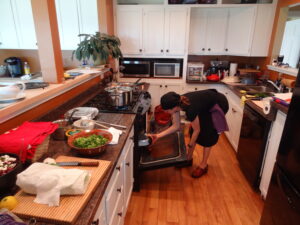
Therapeutic Chef since 1996, food that meets dietary/health needs.
Though the diet is unlikely to be harmful, not all doctors see much potential benefit. Moses writes in an email, “Yeast is ubiquitous in the environment. Pathogenic yeast (those that can cause human disease) are found on household surfaces, in our noses and mouths, and on our skin. These organisms cause disease in a small number of individuals only when immunity is compromised. It is scientifically unproven, and very unlikely that a yeast-free diet has any effect on human disease.”
But Carpenter has her own anecdotal evidence. The chef’s journey of medicinal eating began at age (19), when lifelong asthma and chronic allergies became too much for her to bear. “I would start the day with chocolate, then coffee, and French fries for lunch. That was how I ran my body,” Carpenter says. “I was taking Triaminic and Sudafed like candy to keep my body dried up.”
Realizing that changing her abysmal diet might improve her health, Carpenter made the dramatic leap to macrobiotics. She ate lean and unprocessed foods; rich in vegetables and grains — until another health event made her rethink the method.
During the pregnancy with her second son, now 5, Carpenter developed chronic strep and yeast infections (from a serious, life-threatening prenatal condition called hyperemesis gravidarum). “Macrobiotics wasn’t helping me at that point. I realized I once again had to tighten up my diet,” she recalls.
She runs to her bookshelf to share the book that changed her life: The Body Ecology Diet: Recovering Your Health & Rebuilding Your Immunity by Donna Gates and Linda Schatz. This eating plan entails cutting out gluten, sugar and yeast; Carpenter says that when she was tested two years later, it had eliminated the troublesome yeasts and fungi from her body. She’s now working on a book of her own to help others in similarly dire circumstances.
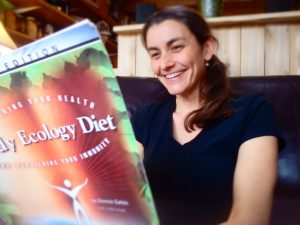
Tara Carpenter, NC. supports people on The Body Ecology Diet.
Already a macrobiotic counselor and healing chef, Carpenter possessed knowledge of Chinese medicine and nutrition that allowed her to think outside the Body Ecology box, combine that plan with other types of low-impact eating and come up with her own methods. In its most basic form, the Happy Bellies diet is based on “properly combining” gluten-, sugar- and yeast-free foods to not feed pathogenic yeast, bacteria or parasites.
What is a proper combination? Carpenter sets forth basic rules designed to enhance digestion of each food: Eat fruits alone or on an empty stomach; eat proteins and starchy foods with non-starchy vegetables. In Chinese terms, these techniques balance the yin and yang of the food.
Those regulations don’t stop Carpenter from setting out a feast for my recent lunch at her home. The meal begins with a shot of Purple Potion, brine left from a dish of cultured, unsalted cabbage and beets. The chef explains the bright-purple concoction is best for children and for adults whose bodies may not yet be conditioned to handle the alcohol-like burn and very diverse (often open air fermentation) of typical fermented food. The slightly chunky shot of Purple Potion is sour enough to taste almost carbonated, yet sweet enough to suggest powerful lemonade.
Making food everyone can enjoy, despite differences in eating.
The aperitif gives way to a cup of red clover, spearmint and raspberry-leaf tea. Carpenter explains that the tisane’s warmth helps relax the stomach for the work it’s about to do. “I rarely start a meal without it — just to let the stomach juices wake up and know that food’s about to arrive,” she says.
To continue the warming trend, she serves a cup of spinach soup. The creamy texture of the dark green potage comes not from dairy, which causes sensitivity in some of Carpenter’s patients, but from sunflower seeds. Specifically, “predigested” sunflower seeds. This isn’t as gross as it sounds; no one chewed up the seeds, mother-bird style. They were simply soaked in salt water to remove hard-to-digest phytic acid.
The rest of the meal is a global mashup of whole-fat, high-nutrient foods. Though many of Carpenter’s patients are sensitive to eggs, she says the problems are usually caused by proteins in the albumen. Yolks rarely cause the same damage to the “gut lining,” the chef says. Hence her frittatas, a popular choice with patients and at catering gigs, which combine creamy egg yolks with matchsticks of zucchini, seasoned with dill and parsley.
Along with a pair of fermented salads Carpenter offers a conventional one featuring radicchio, shiitakes and artichokes. Though “conventional” may not be the right word. One bite reveals the addition of bacon fat, which gives the bowl of greens a luscious waft of fatty smoke. A glowing green dressing of avocado and lime lends a bright flavor without added oils.
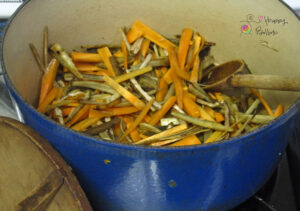
The burdock was harvested in Vermont, cut in matchsticks with carrot then sauteed in duck fat with sea salt kinpira style by gently pressing the vegetables with a tight-fitting wooden lid inside a heavy pot with another lid, until fragrant and liquid releases.
Another vegetable dish, Japanese kinpira gobo, showcases Carpenter’s predilections not only for wild foods but for using every part of pastured animals. She wildcrafted the burdock at her older son’s elementary school. The blood purifier and prebiotic (feeds good intestinal flora) is stir-fried with carrots in the fat from a goose that Carpenter purchased from a local farmer. Currently, pieces of a whole lamb, including nutrient-rich liver and heart, wait in her chest freezer, the result of the first slaughter she and her husband, Tomas Vondra, accomplished.
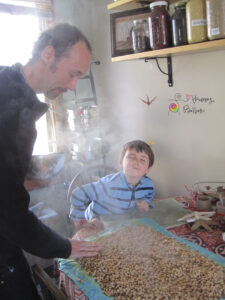
Tara’s husband, Tomáš, makes natto with son Thomas.
Vondra, a Czech architect who makes a mean natto (a gooey, cheesy-tasting Japanese fermented-soybean dish), is designing (the home and potential) learning center of sorts for he and Carpenter in Cabot. The center and gardens is adjacent to Rhapsody Farm where the Welters family grows rice for a fermented drink called amazake, and processes the tempeh it started selling at the now-closed Rhapsody Café in Montpelier in 1997.
Once (her home) is built, Carpenter may invite clients to learn to cook their own food in a commercial kitchen, using the foods she grows and advocates — as well as Rhapsody tempeh, of course.
Though Carpenter’s job title is therapeutic personal chef, she says she prefers to teach clients how to make their own food rather than prepare it for them. “Having a personal therapeutic chef isn’t for everybody,” she says. “My motto is to teach people to fish for themselves. Cooking is wonderful, but I want to teach.”
Customized meal plans are among Happy Bellies’ most popular service. Still, “hitting the bull’s-eye” every day, as Carpenter puts it, can be a challenge. Not everyone has time to make their own stocks and ferment their own veggies. Other clients are too ill to cook for themselves (plan + recipes can be easily followed by a family member, friend, or chef).
A full-time student and mom, Carpenter finds time to maintain two or three personal chef clients at a time. These have sometimes included patients in hospice care, whom Carpenter seeks to comfort by balancing their yin and yang with warming or cooling foods.
On the other end of the spectrum, Carpenter particularly enjoys working with postnatal mothers. She is one of New England’s few certified placenta encapsulation specialists, meaning she dehydrates the mother’s placenta for her to consume in capsules, a practice meant to restore hormones and nutrients lost in childbirth. Demand is such that Carpenter drives all over the region several times a month to encapsulate, where she steams, dehydrates, grinds and puts placenta into empty capsules for clients (with an FDA-approved Traditional Chinese Medicine method (TCM).
Carpenter offers a byproduct of the encapsulation process called mother’s tea, a liquid Carpenter recommends mothers mix into soup or stew. For women not ready to take the plunge of eating their own organ, she freezes the tea, in case they decide to try it later. “Placenta helps to tighten things up and bring warmth to the organs, especially to the reproductive organs,” Carpenter says. “When they take mother’s tea, they often feel a difference within an hour.”
Nutritionist Gardner, a vegetarian, wouldn’t eat mother’s tea herself but says she can see the benefits of this practice. “It seems like it’s not just an old wives’ tale,” she says. “Placentas are really rich in proteins and irons. Their stem cells are special, powerful, very nutritious cells — the essence.”
Controversial as some of Carpenter’s claims may be, no one can argue with the flavors of Happy Bellies’ cuisine, and dishes such as lamb kebabs and Caribbean lime halibut are far from boring health food. And Carpenter isn’t afraid to serve up rich desserts, such as ghee-based truffles she calls Cinnamon Kisses, leaving clients feeling they can enjoy food without fear, whether at home or at a restaurant, is Carpenter’s way of keeping them healthy for life.
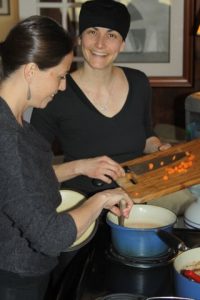
Give a man a fish, feed him for a day.
Teach a man to fish, feed him for a lifetime.
You can best reach Tara Carpenter, NC. by email at tara@happybellies.net.
Source URL: https://www.7dvt.com/2013happy-bellies-chef-teaches-clients-eat-digestive-health
Links:
[1] https://www.happybellies.net/
[2] https://preventivemedicinevt.com/
[3] https://www.uvm.edu/medicine/medicine/gastro/?Page=profile.php&bioID=22563
[4] https://www.7dvt.com/2011rhapsody-moves
The print version of this article was headlined “Intestinal Fortitude”.
© 2024 Seven Days



2 replies on “Intestinal Fortitude: Happy Bellies Teaches to Eat for Digestive Health”
Jenneta,
I had the Comprehensive Digestive Stool Analysis test redone (https://www.gdx.net/product/10140).
I knew before this test that I had gained control over my systemic Candida because many of my symptoms had disappeared. While there are many symptoms identified with systemic candida, those listed below are most common:
Headaches
Feeling Spacey or disconnected with ones surroundings
Fatigue
Excessive sleeping
Insomnia
Digestive complaints
Diarrhea and/or constipation
Tingling of hands/feet
Vaginal discharge
Repeated vaginal infections
Adult onset allergies
Sensitivity to smells
Systemic Candida is usually diagnosed by appearance and symptoms and lab tests are performed if infection does not clear with treatment. There is no real accurate medical test for systemic candida, as once the organism has left the intestinal tract and entered the blood stream it is difficult to trace.
One of the best ways to determine if a systemic yeast problem is present is by observing your symptoms. If you are uncertain whether you may have a systemic yeast problem, a great first step is to take Donna Gates’ Candida Evaluation Test(found in The Body Ecology Diet book). This test can also be accessed online at https://bodyecology.com/quiz.php.
Tara,
It says that it took you two years to clear yeast out of your system. What tests did you use to find it out?
Thank you,
Jenneta